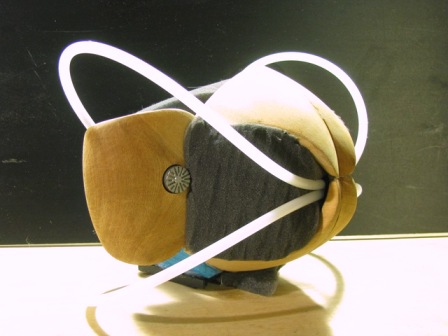

The Wooden Bowl Array
I cut apart a wooden bowl and reassembled it to approximate Crown SASS system characteristics except with less angle between axes of the microphone capsules and with a narrower front to the baffle nose piece, and with curved surfaces instead of flat.
My idea was that a curved surface to the boundary plane could allow some of the surface to be oriented more directly forward while still maintaining some boundary effect out to 90 degrees - and maybe it would even create a more natural sounding transition to the rear.
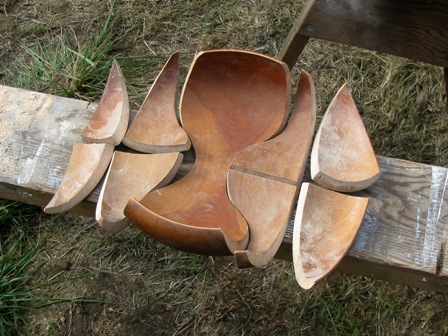
a wooden bowl cut to pieces
I found a wooden bowl at a second hand store that met my requirements for size and shape. First, I cut out the shape for the main boundaries, and then I figured a way to use the leftovers to build the nose piece. I made the microphone mounts and tripod mount out of dense foam from a yoga block. All the components were bonded together using hot glue. The open-cell foam used for the baffle nose is an element of the original SASS design that allows low frequency sounds to pass through. Initially I used what ever foam I had on hand, but replaced that with foam from Rob Danielson for consistency with his related experiments .
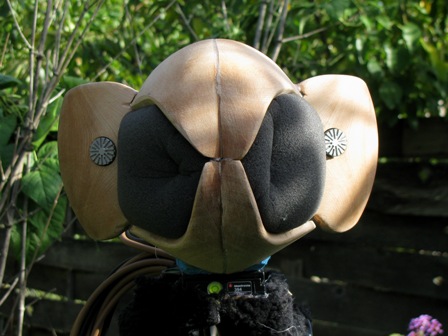
Front view.

Back View.
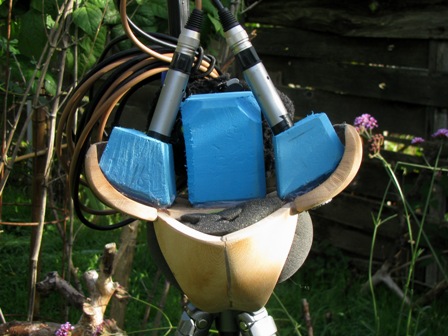
Top view.
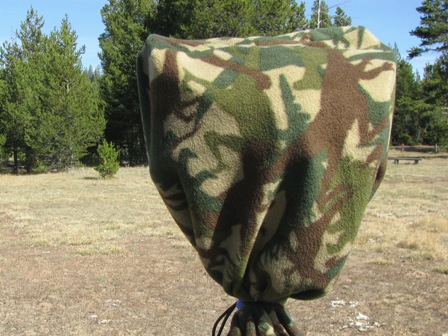
camo pajama fleece wind screen

on location
LOCALIZATION TESTS are a way to understand stereo imagery characteristics of an array by analyzing the playback imagery of sounds recorded from identified physical locations. A common method is to make a recording while walking a perimeter around the microphones and stating positions along the way. My walk around tests were performed at 30 foot and 100 foot radii, and a snapping sound (clothes pin snapping) was used in addition to spoken clock positions in order to add a consistent, broad frequency signal for lab analysis. An additional free-air comparison test was made using the same microphones and positioning except without the wooden bowl array.
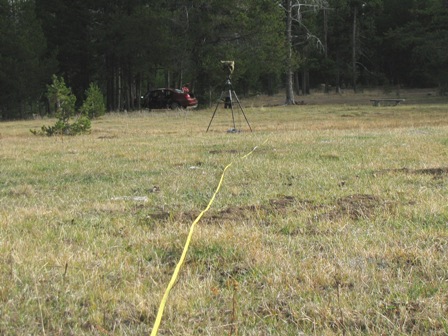
measuring for localization test
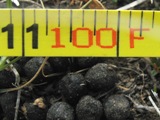
deer poop at 100ft
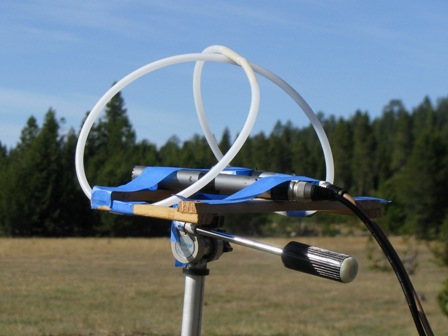
makeshift free-air array

panorama 6 to 12 o-clock

panorama 12 to 6 o-clock
Click here for a large size, full panorama.
free-air array localization test at 30 feet radius
wooden bowl array localization test at 30 feet radius
wooden bowl array localization test at 100 feet radius
IN REVIEW of my localization tests, the first thing I noticed was the 12 o'clock and 6 o'clock positions both sound somewhat off center - both shifted to the left. Frequency analysis in my editing software suggests the left channel is about 2 dB louder than the right. Analysis of the free air test also shows this difference between the channels, suggesting the difference is not caused by the wooden bowl array. Other than that, to my ear the stereo imagery of the wooden bowl array sounds good.
Though more insights to this particular array will certainly arise through further analysis in the lab, the true potential can only be revealed though real applications in the field. The night prior to my tests, and from the same location, I got lucky to record some owls and coyotes. This recording has been edited to highlight the animal voices within the natural reverberation of the landscape. Play the clip under the photo below.
coyotes and owls
- end -
The recordings, photos, and all content of this
webpage belong to John Hartog. Commercial use is not permitted.
Outdoor playback in the wild is highly discouraged.
If you have any questions or comments,
please visit our contact page
and send us an email.
John Hartog
Natural Soundscape Recording
Portland, Oregon USA
rockscallop.org
A tribute to the world's vanishing quiet places
|